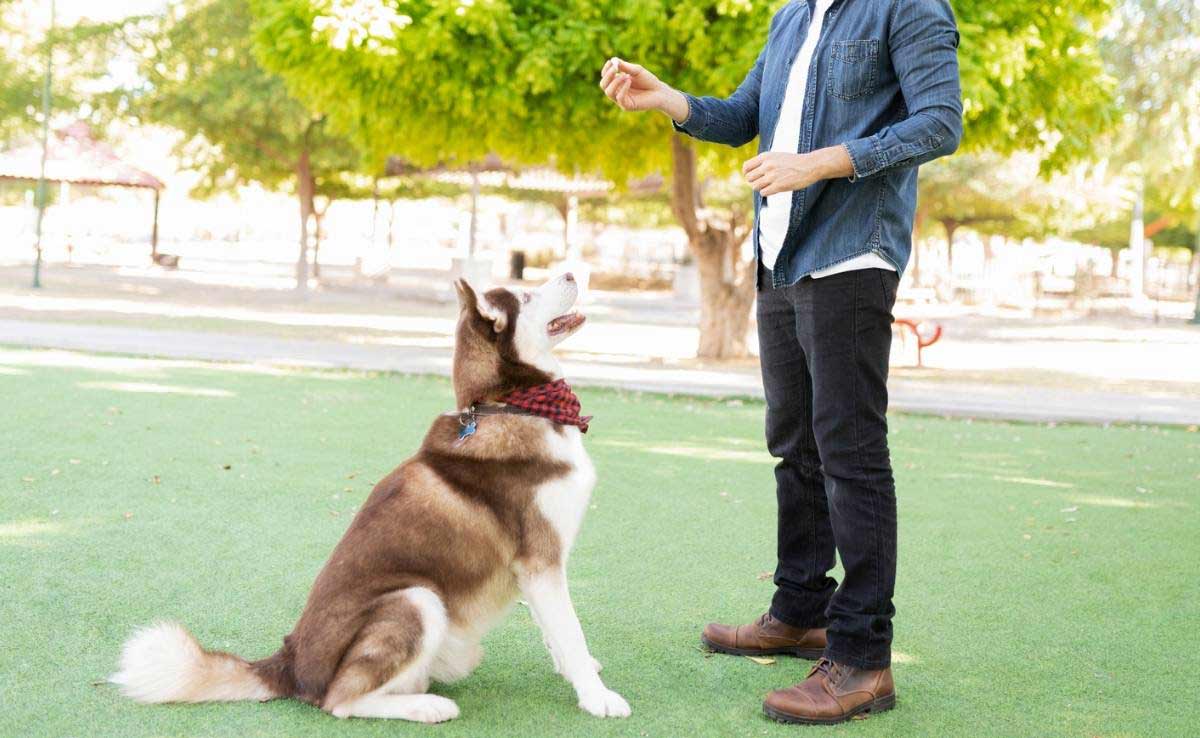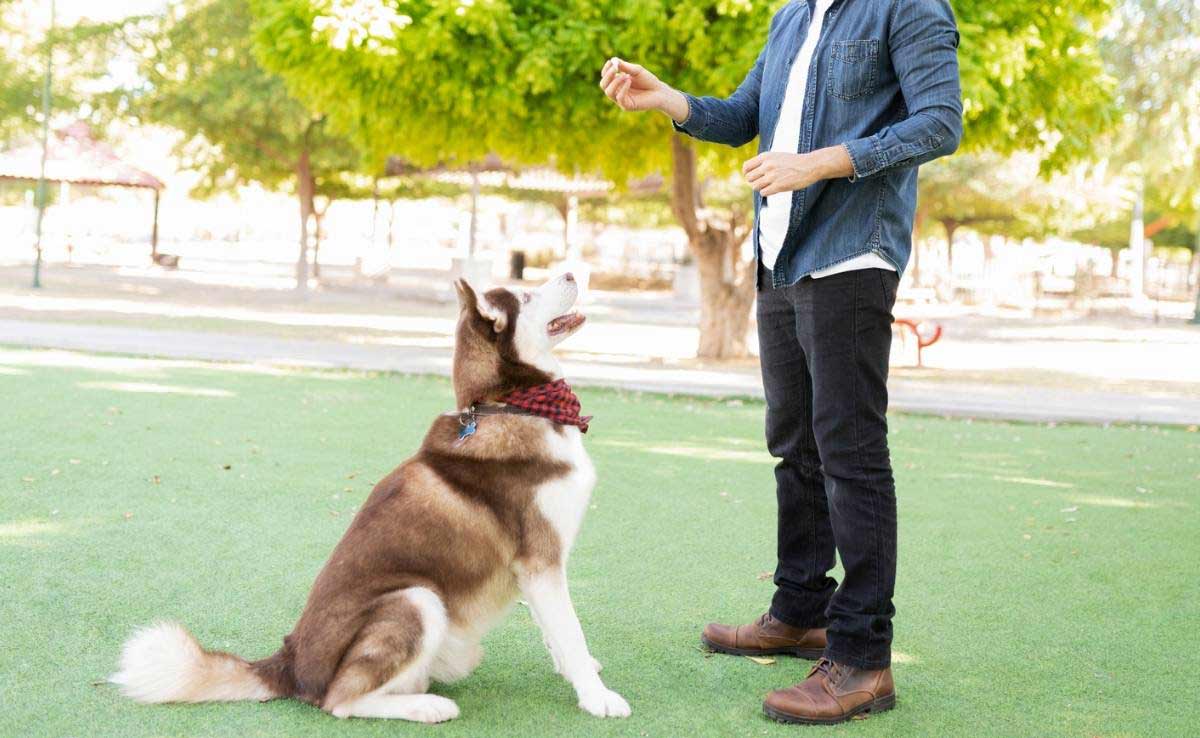
To keep the lights on, we receive affiliate commissions via some of our links. Our review process.

“Sit” is one of the most important skills for dogs to learn. Teaching your pup to sit helps control your dog’s behavior in many different situations, like jumping up on people or running around in public places. “Sit” is also when your dog begins to learn what’s expected of her, and it gives your furry friend a foundation you can build upon when you’re training other skills. Fortunately, for most dogs, “sit” is one of the easiest commands to master. Follow our step-by-step guide to get your pup sitting in no time.
Before You Begin Training
Contents
If you have a young puppy, you may be wondering when you can start teaching her “sit” and other basic obedience commands. Experts agree that you can begin basic dog training as early as seven to eight weeks of age. And if you’ve adopted an older dog who doesn’t know basic commands, “sit” is a perfect place to start.
The best way to teach a dog to sit is to use positive reinforcement, giving your dog a lot of praise and rewarding her with training treats (we recommend Zuke’s Mini Naturals) or a toy when she performs. Using a treat pouch can make your training easier. Finally, you may also want to consider clicker training, a popular method of marking desired behaviors used by many professional trainers.
Expert Tip: Never use a harsh voice, negative body language, or any type of punishment when training your dog. Research has shown that these and other aversive training techniques can have detrimental effects on your furry friend.
How To Teach A Puppy To Sit
It’s always a good idea to train in a quiet area of your house with limited distractions to help your dog focus. And limit your training sessions to 5-10 minutes for puppies and no more than 20 minutes for adult dogs.
Step 1: Lure Your Dog To Sit
- Put a treat in your hand.
- With your dog standing in front of you, hold the treat close to her nose.
- Slowly move your hand above and slightly toward the rear of your pup’s head. Your dog will lift her head and back up a bit to follow the treat with her nose. This should cause your pup to lower her back end to the floor.
- As soon as her rear hits the floor, praise/click and reward her with the treat for being in the sit position.
- Get her back into a standing position by walking away and calling her to you.
- Repeat this process until your pup is reliably getting into the sit position with your hand lure.
Expert Tips:
- Although it may be tempting, don’t push your dog’s rear end into a sitting position. This can be confusing and stressful for dogs. You want them to naturally go into the sit position.
- If your pup is jumping up to get the treat in your hand, you’re probably lifting it too high. Try keeping your hand closer to her nose and slowing it way down when you raise your hand.
- If your dog doesn’t seem into the treat or other lure you’re using, try something you think may better motivate your pup (e.g., a higher quality treat, a different toy, etc.).
Step 2: Add A Verbal Cue
Once your dog has caught on with the hand lure, it’s time to add your verbal cue.
- Just before you use your hand lure, say, “sit.”
- Then, immediately lure your dog to sit, praise/click, and reward with a treat.
- Repeat. Your dog will eventually associate your verbal cue with her moving into the sit position.
Step 3: Fade Out The Lure
- Put a treat in your other hand and leave your lure hand empty.
- Say “sit,” and then use your empty hand to lure your dog to sit. (Now, your empty hand is your hand signal to sit.)
- Praise/click and reward with the treat from your other hand.
- Repeat. Then you can try to eliminate giving your dog a treat from your other hand (but continue to praise/click every time your dog sits). This may take some time for your pup to catch on.
- With repeated practice, you can also fade out the hand signal so your dog will simply sit with your verbal cue.
Expert Tip: Once your canine companion has mastered “sit,” practice in your yard, while you’re on walks, or at the dog park. Because there are added distractions now, you may need to add a treat reward back into the mix temporarily to get her attention.
Capturing “Sit”
While you’re still doing sit training sessions with your dog, you can reinforce that training with a technique called capturing. This simply means that you praise/click and reward your dog during the day whenever she sits on her own. Eventually, your furry friend will begin sitting on her own because she knows it’s a desired behavior.
How To Train A Puppy To Sit From Down Position
The concept of training a dog to sit from the down position is the same as above. When your dog is lying on the ground, hold a treat to her nose and slowly raise it until she’s in a sitting position. Praise/click and reward. Repeat and add in your verbal “sit” cue as your pup is moving into the upright sitting position.
How To Train A Dog To Sit And Stay
“Stay” is much more difficult for dogs to grasp. Before moving on to “stay,” make sure your pup has thoroughly mastered “sit.”
- First, teach your dog a release cue like “okay” or “go.”
- With your dog in a sitting position and you standing in front of her, toss a treat on the floor and give your release cue as your pup moves toward the treat. Repeat.
- Keep working on your release command until your dog begins to move when you only give your cue. Then you can treat once your dog is moving. Repeat until you no longer need to treat.
- To move onto “stay,” first work on duration. Tell your dog “sit” and wait a few seconds before you praise/click and give her a treat.
- Tell your dog to sit again and wait a few more seconds before rewarding a treat. Repeat, gradually increasing the time delay between your “sit” command and reward until you can reach about 10 or 15 seconds.
- Next, it’s time to add your “stay” cue. Ask your dog to sit and then say, “stay.” Take one step back, then step forward to your pup. Praise/click, reward, and say your release cue.
- Repeat several times. Practice facing your dog and with your back turned toward her.
- Gradually add more distance to this process and begin adding in your release cue.
- Be patient! It can take dogs a long time to master stay.
How To Teach A Dog To Sit Pretty (With Video)
Once you’ve mastered “sit,” you can kick up your pup’s wow factor (and cuteness) by teaching her to “sit pretty.” Sitting pretty, also commonly called “beg,” is a popular dog trick where your fuzzy friend sits on her hind legs with her front legs off the ground and curled up in front of her. This brief video shows you how to train your pup to sit pretty.
Do You Need Training Assistance?
As you progress past “sit,” training other commands can get more challenging. If you’re having difficulty with new skills or if your pup’s having specific behavior issues like leash-pulling or aggression, you may want to consider an online dog training course or a dog training app. These options are much more affordable than hiring an in-person professional dog trainer. The best courses include step-by-step instructions from dog behavioral experts, and some even give you virtual access to certified trainers.
Tagged With: Training